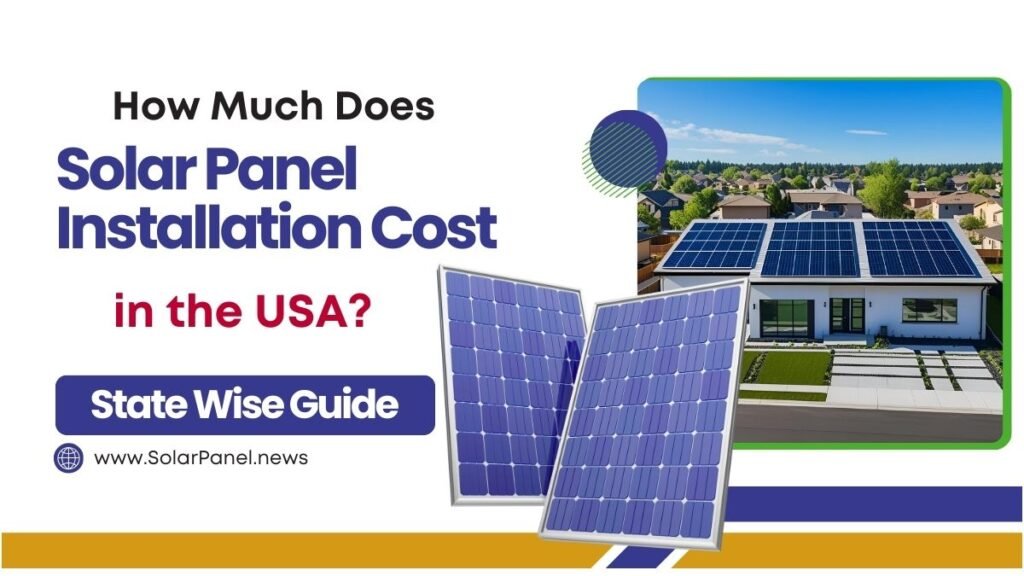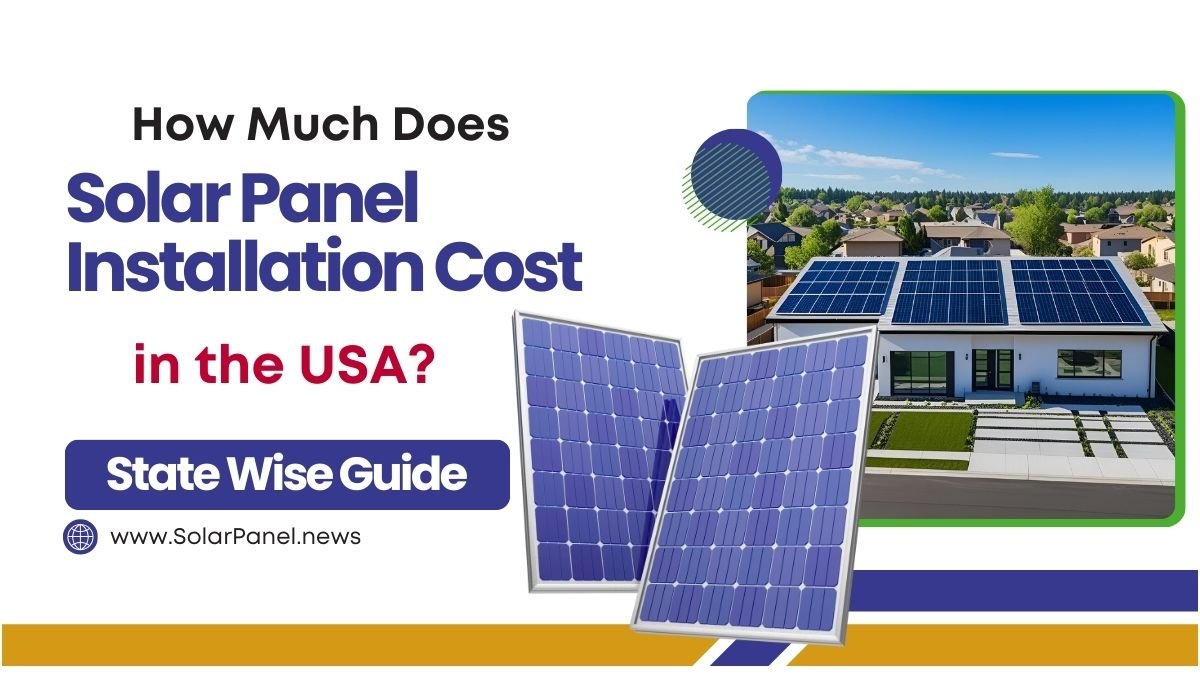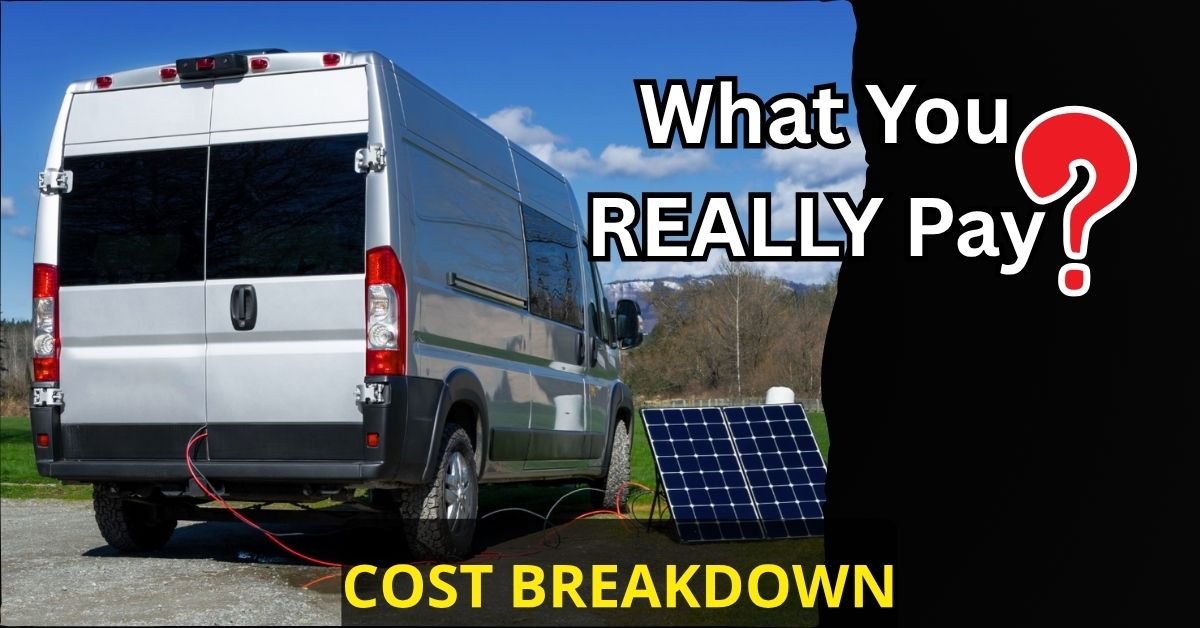Solar Panel Installation Cost USA: Are you considering solar panel installation but unsure what it’ll cost? In 2025, going solar is more affordable than ever, especially with federal incentives, falling equipment prices, and rising electricity rates making the switch financially smart.
Whether you’re in California, Los Angeles or New York, understanding the solar panel installation cost in the USA can help you make a confident, budget-friendly choice. This guide discusses everything from state-by-state pricing to tax credits and even tools to calculate your savings. Let’s go now!
Key Factors Influencing Solar Costs in the USA
Several variables determine the actual cost of solar installation in the U.S. in 2025. Understanding these factors can help you budget smarter and potentially save thousands.
🏛️ Federal Solar Tax Credit (ITC)
The Investment Tax Credit (ITC) remains one of the biggest money-savers. In 2025, the federal government will still offer a 30% tax credit for residential solar systems under the Inflation Reduction Act (IRA). This credit applies to:
- Equipment (panels, inverter, batteries)
- Labor and permitting costs
- Sales taxes
Example: A $20,000 solar system would qualify for a $6,000 tax credit.
🗺️ State-Wise Incentives
Depending on where you live, state and local incentives can significantly lower your net costs. Some states offer:
- Property tax exemptions (e.g., Florida)
- Sales tax exemptions (e.g., Massachusetts)
- Performance-based incentives (e.g., New York’s NY-Sun)
💼 Local Labor Rates
Installation labor rates can vary greatly. For instance:
- Urban areas with union labor may cost more
- Rural areas may have lower installation fees but fewer provider options
🌤️ Climate & Roof Conditions
- High solar potential states (e.g., Arizona, California) see faster ROI
- Shaded or complex rooftops may require additional equipment like microinverters, increasing costs
Average Solar Panel Installation Cost Across the USA (2025 Update)
How much does it cost to install solar panels in your state? Here’s a 2025 snapshot of average installation prices after the 30% federal tax credit:

🔋 Estimated cost based on reference (for 5kW-10kW systems, excluding federal tax credits).
| State | Avg. Cost (Before Incentives) | Avg. Cost per Watt |
| Alabama | $13,000 – $25,000 | $2.60 – $2.80 |
| Alaska | $14,000 – $27,000 | $2.80 – $3.00 |
| Arizona | $12,000 – $22,000 | $2.30 – $2.60 |
| Arkansas | $13,000 – $24,000 | $2.60 – $2.80 |
| California | $12,000 – $23,000 | $2.30 – $2.70 |
| Colorado | $13,000 – $24,000 | $2.50 – $2.80 |
| Connecticut | $14,000 – $26,000 | $2.70 – $2.90 |
| Delaware | $13,000 – $25,000 | $2.60 – $2.80 |
| Florida | $11,500 – $21,500 | $2.20 – $2.50 |
| Georgia | $12,500 – $23,000 | $2.40 – $2.60 |
| Hawaii | $15,000 – $27,000 | $2.80 – $3.10 |
| Idaho | $13,000 – $24,000 | $2.60 – $2.80 |
| Illinois | $13,500 – $25,000 | $2.60 – $2.90 |
| Indiana | $12,500 – $23,000 | $2.50 – $2.70 |
| Iowa | $13,000 – $24,000 | $2.60 – $2.80 |
| Kansas | $12,500 – $23,000 | $2.50 – $2.70 |
| Kentucky | $13,000 – $24,000 | $2.60 – $2.80 |
| Louisiana | $13,000 – $25,000 | $2.60 – $2.90 |
| Maine | $14,000 – $26,000 | $2.70 – $2.90 |
| Maryland | $13,000 – $24,500 | $2.60 – $2.80 |
| Massachusetts | $14,000 – $26,000 | $2.70 – $2.90 |
| Michigan | $13,000 – $24,000 | $2.60 – $2.80 |
| Minnesota | $13,000 – $25,000 | $2.60 – $2.90 |
| Mississippi | $13,500 – $25,000 | $2.60 – $2.90 |
| Missouri | $12,500 – $23,500 | $2.50 – $2.70 |
| Montana | $13,000 – $24,000 | $2.60 – $2.80 |
| Nebraska | $13,000 – $24,500 | $2.60 – $2.80 |
| Nevada | $12,500 – $23,000 | $2.40 – $2.60 |
| New Hampshire | $14,000 – $26,000 | $2.70 – $2.90 |
| New Jersey | $13,500 – $25,000 | $2.60 – $2.90 |
| New Mexico | $12,000 – $22,500 | $2.30 – $2.60 |
| New York | $13,500 – $25,000 | $2.60 – $2.90 |
| North Carolina | $12,500 – $23,500 | $2.40 – $2.70 |
| North Dakota | $13,500 – $25,000 | $2.60 – $2.90 |
| Ohio | $12,500 – $23,500 | $2.50 – $2.70 |
| Oklahoma | $13,000 – $24,500 | $2.60 – $2.80 |
| Oregon | $13,500 – $25,000 | $2.60 – $2.90 |
| Pennsylvania | $13,000 – $24,500 | $2.60 – $2.80 |
| Rhode Island | $14,000 – $26,000 | $2.70 – $2.90 |
| South Carolina | $12,500 – $23,500 | $2.40 – $2.70 |
| South Dakota | $13,000 – $24,000 | $2.60 – $2.80 |
| Tennessee | $13,000 – $24,500 | $2.60 – $2.80 |
| Texas | $12,500 – $23,500 | $2.40 – $2.70 |
| Utah | $13,000 – $24,500 | $2.60 – $2.80 |
| Vermont | $14,000 – $26,000 | $2.70 – $2.90 |
| Virginia | $13,000 – $24,500 | $2.60 – $2.80 |
| Washington | $13,500 – $25,000 | $2.60 – $2.90 |
| West Virginia | $13,000 – $24,500 | $2.60 – $2.80 |
| Wisconsin | $13,000 – $24,500 | $2.60 – $2.80 |
| Wyoming | $13,500 – $25,000 | $2.60 – $2.90 |
📌 দ্রষ্টব্য:
- This information is based on average costs. Actual costs depend on system size, brand, location, installation type (ground/roof mount), incentives, and installer rates.
- Costs can be significantly reduced if federal tax credits (ITC – 30%) are available.
💡 Tip: Higher wattage systems often come with better cost-per-watt savings.
Is Solar Getting Cheaper in 2025?
✅ Yes! Here are more ways than one:
🔻 Falling Equipment Prices
Thanks to advancements in solar tech and increased domestic manufacturing, panel prices in 2025 are down 8-12% from 2023.
📉 Net Metering Shifts
While some states like California have adjusted net metering (NEM 3.0), many others still offer favorable buy-back rates for surplus energy. States like New Jersey and Illinois continue to reward solar exports.
⚖️ Policy Updates
- IRA-backed incentives remain strong through 2032
- More utilities are launching battery rebates, helping homeowners go solar-plus-storage affordably
How to Cut Solar Installation Costs in the USA
Want to lower your upfront investment without compromising quality? Here are smart strategies to reduce your upfront investment:
✅ Claim All Available Credits
- Federal ITC: 30% off total system cost
- State rebates: Up to $1,000-$3,000 depending on location
- Utility rebates: Some providers (like Duke Energy) offer $250–$600 off
Use Available Tax Credits
Claim the 30% federal tax credit and check if your state offers additional rebates or cash-back programs.
Join a Group Buy Program
Some communities and co-ops organize group purchases to negotiate bulk discounts with installers.
Choose High-Efficiency Panels
While they cost more upfront, high-efficiency panels produce more energy, reducing long-term costs and possibly the number of panels needed.
Optimize Your Roof Design
Work with installers to design a layout that maximizes sun exposure and minimizes shading.
Finance Wisely
Consider:
- Solar loans with no upfront cost
- Leases/PPAs for reduced entry costs (though long-term savings may be lower).
Free & Paid Solar Estimator Tools for USA Homeowners
Before calling an installer, try these tools to estimate your solar potential and costs:
| Tool | Type | Features |
| Google Project Sunroof | Free | Uses your rooftop’s satellite imagery for solar output prediction |
| EnergySage Solar Calculator | Free | Side-by-side installer quotes, ROI and savings data |
| PVWatts (NREL) | Free | Technical modeling by ZIP code and system size |
| SolarReviews Estimator | Free | Cost and payback calculator based on state/utility |
| Solar.com | Free/Paid | Personalized installer matching with cost breakdowns |
Local Utility Calculators
Many utility companies offer their own solar calculators tailored to regional rates and incentives.
Using these tools helps you compare offers and find the best deal.
Final Thoughts: ROI & Payback Time
So what’s the bottom line in 2025?
- Average ROI: 15%-20% annually, depending on state and utility rates.
- Typical Payback Period: 6-9 years.
- Lifetime Savings: $15,000–$40,000 over 25 years.
If you’re planning to stay in your home long-term, solar in 2025 is not just affordable, it’s smart. Pair it with battery storage or EV charging, and you’ll future-proof your energy bills for decades.
✅ Summary of deciding to install solar panels on your home
- The average solar panel installation cost in the USA in 2025 ranges from $2.50 to $3.70 per watt.
- Federal and state incentives like the ITC can cut your costs by up to 30%.
- Prices are trending downward thanks to policy support and technological advances.
- Use free tools like EnergySage and Google Project Sunroof to get accurate cost estimates.
- Most homeowners see a payback period of 6-10 years, followed by decades of free electricity.
Ready to go solar? Start by comparing quotes from trusted installers and take advantage of today’s incentives before they phase out.
Mini FAQ: People Also Ask
Q: What’s the cheapest state to install solar in 2025?
A: Florida, Arizona, and Texas consistently offer the lowest costs due to low labor rates and strong sunlight.
Q: Can I get solar for free in the USA?
A: While no system is 100% free, some leasing options or low-income programs may cover upfront costs.
Q: Is solar worth it in colder states like New York or Illinois?
A: Yes! Modern panels work efficiently in cold climates, and generous state incentives make it a smart investment.
Q: How long do solar panels last in 2025?
A: Most panels come with 25-30 year warranties and retain 80%+ efficiency even after two decades.
You can read also: PWM vs MPPT Charge Controller (Which One to Choose?)
Ready to Get a Personalized Solar Quote?
📞 Contact a local installer today or use EnergySage’s free tool to compare prices and maximize savings!







